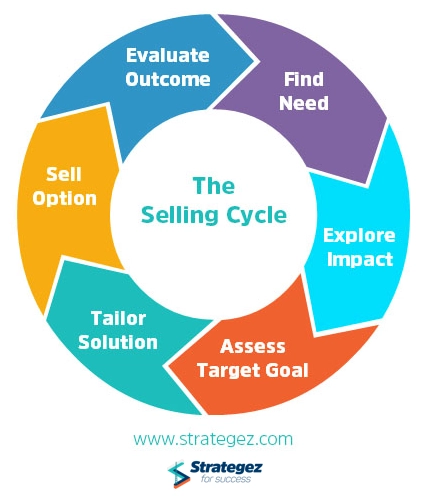What is a Sales Cycle?
A sales cycle refers to the process that a company uses to sell its products or services.
The sales cycle can be divided into four stages: prospecting, qualification, needs analysis, and closing.
It’s in a company’s best interest to have a sales process. That allows them to organize their sales funnel, prioritizes their opportunities, and evaluates the effectiveness of their sales team.
A sales cycle is a process that salespeople use to take potential customers through the stages of becoming qualified leads.
By having a defined sales cycle, reps can ensure they are taking the necessary steps to turn a lead into a customer. Additionally, cohesion is important to a sales team, and by having common reference points, teammates can better understand what each other are doing.Understanding the Sales Cycle
Your sales process is a set of steps your sales reps take when selling your product or service.
The sales process for each company is different, but understanding it can help you optimize your sales team.
There are five general sales cycle stages, but the details may vary from business to business and industry to industry.
Most businesses follow the following sales process steps: Prospecting, Qualification, Consideration, Decision, Closing, and Referral.
In the prospection step, reps make initial contact with potential customers. The qualification stage is where the rep learns about the potential customer’s pain point. In the consideration, the sales rep presents their solution and in the decision making, the customer needs to make a decision. Finally, in the closing, the customer makes a decision. In the referral, the customer refers a friend.A sales cycle can be visualized as a funnel, with each stage representing a stage in the sales process.
The length of your sales cycles is incredibly important.
Sales professionals are always reviewing the length of sales cycles statistics to identify areas where the process may be slowing down.
By understanding which stages of the sales cycle are taking longer than others, they can work to find ways to reduce the overall timeframe. This is critical in ensuring that their organization remains competitive.The goal is to reduce the amount of time it takes to complete a sale.
Why?
The faster a company can complete a sale, the more money they will earn. This is because they can sell more products in less time.
Importance of Reviewing Sales Cycle Length
The average length of a sales process can help you predict your sales forecast.
With the amount of incoming sales, you can estimate what your future revenue will be.
By setting up a KPI, you can shorten your sales cycle, speeding up your cash flow.
You can also analyze which areas are taking up the most time.
Additionally, you can figure out which months of the year or week are hitting the expected average or falling behind.When looking at an individual representative’s stats, you can see the average length of their sales cycles.
Stages of a Sales Cycle
A sales cycle typically consists of six stages: prospecting, connecting, researching, presenting, handling objections, and closing.
However, the cycle doesn’t end there. Once a sale is made, it’s important to follow up with the customer and generate referrals for future business.1. Prospecting stage
Use social media, check the news, and reach out to your network. Finding new contacts and reaching out to them can be one of the most crucial parts of selling.
In this stage of the sales process, you’ll identify the types of people most likely to buy from you, and who fit your definition of an ideal customer.
For more tips on making successful phone calls, check out the ultimate guide.
2. Connect With Prospects
Once you’ve found a prospect, it’s up to you to make the first move.
Try reaching out to them via mutual acquaintances, engaging them via social media sites, and reaching out via email and over the phone.Share your value, and ask if they’d like to hear more about it.
Hello [prospect], my name is [your first_name], and I work for [company].
Hi there! Is [pain point] something your company is struggling with? I specialize in helping companies like yours [insert benefit you offer]. I’m confident I could do the same for you. Let’s chat and see if my services are a good fit for you.
Are you interested in learning more?
3. Research
When a prospect expresses interest in learning more about your business, it’s time to set up a phone call.
During this phone call, you’ll learn more about the business, their specific needs, and whether or not you can meet those needs.Some sales conversations end with you realizing that you’re not a good fit for each other.
Other times, they give you the insights you need to make a strong pitch for their purchase of your product or service.Not sure what questions to ask a prospect? Contact us today and we'll draft a list tailored specifically to your needs.
4. Present Your Sales Pitch
Now, it’s time to present your sales pitch.
This usually revolves around a sales script your salespeople customize for each business’ unique needs.Typically, you’ll meet with a group of stakeholders at a prospect’s organization and present your solution to their key decision-makers.
5. Handle Proposal Objections
Your sales cycles aren’t always going to go as smoothly as you’d like. It’s likely that you’ll run into some resistance from a prospect or two.
Your customers are bound to have some questions about your product.
After your pitch, you’ll have to deal with any pushback from your prospects.
They might ask a lot of questions about pricing, their budget, competitors, product understanding, or their business issues.
Be prepared to listen attentively to your prospect’s objections, asking for clarification where needed. Try to understand their objection from their perspective, then address it accordingly.
6. Closing Deals
After your presentation, it’s likely you’ll have some follow-up steps. You’ll need to get in touch with your legal team or IT department on logistics.
It’s time to ask for the sale. Do you feel ready to move forward with this purchase?
If they say yes, great! Draw up the contract and send it over for final review and signing. If they say no, don’t worry!
You might just have to address further objections or walk away from their business for the moment.7. Follow-up
The sales process doesn’t end when you close the deal. After you land a new customer, you have to work to keep them happy, onboard them, and turn them into a marketing asset.
Do your best to provide excellent customer service and follow up.
Be there for your customer. By being their advocate, you’ll always be able to upsell them.
When you have satisfied customers, they can be a great resource for new business opportunities and referrals.
This keeps your sales cycle moving forward, helps you build more relationships, and of course, drives revenue.Sales Cycle Management
First of all, it's crucial to understand that sales cycle management is a vital tool for salespeople, sales managers, and leaders. It allows them to track each stage of the sales process, identify trends, and determine which steps need to be improved.
Without sales cycle management, it would be difficult to make necessary adjustments and improvements to the sales process.Sales cycle management is a crucial tool for salespeople and sales leaders. It allows you to track progress throughout the sales process, identify areas that need improvement, and make necessary adjustments.
A CRM system can be a valuable asset in managing the sales cycle effectively.Sales cycles are a key part of every salesperson’s day. By understanding the cycle your team uses, you can navigate the challenges of selling more effectively.
How to Calculate the Length of a Sales Cycle
The easiest way to track the length of your sales cycle is to start at the point of creation for a lead in your CRM.
To get an accurate measurement, make sure to end the sales cycle at the point the deal closes.A CRM can help you visualize your sales pipeline.
With this approach, your sales teams and marketing teams will be able to see the entire customer lifecycle.
From this, your marketing team can learn how to improve its lead gen and sales prospecting activities, while your sales reps can learn more about how to nurture their sales pipeline.These early stages of the sales pipeline are crucial for moving a prospect through the sales process. Without them, the customer may not progress through the funnel quickly enough.
There is some debate over when exactly a “lead” is created.
Some marketers say that a “lead” is anyone who’s ever filled out a form, while others say a “Lead” is someone you’ve actually contacted.A prospect who downloads a whitepaper from your site and then requests a sales demo several months later creates two contacts in your CRM.
That initial contact with the second prospect is what made that into a possible sale, thus starting the sales pipeline.
If you want to calculate the length of a sales cycle, you need to credit the moment when you receive that list or the person first signs up.
This is called first touch attribution.
If your sales organization has multiple touch points attributed to a single opportunity, measuring the length of the sales cycle can become complicated.
For example, if there is an initial lead creation followed by a request for a demo, you would need to take into account all of these factors to get an accurate measurement.Multi-touch attribution is when you attribute a conversion to multiple marketing channels.
The average length of sales cycle can be calculated by using the following equations:
Number of Days From First Contact + Customer Conversion = Number of Days for Combined Sales
The total number of days for all combined sales is the sum of the number of days from the first contact with the customer conversion for each deal.
Total # of Sales / # of Closes = Average Length of Sales Cycle
The average length of the sales cycle for your company can be calculated by dividing the total number of sales by the number of deals closed.
That’s it!
In the end, automating your sales process with modern sales software can reduce a large part of the burden of analysis.
This can be especially helpful when you automate CRM data entry, analyzing conversion length, and the creation of reports based on different deals, different teams, or individual sales representatives.
Automation software can provide you with insightful reports based on data pertaining to your sales operations and teams.
This allows sales reps to have more time to focus on selling.When it comes to calculating your sales life cycle, there is no one-size-fits-all solution.
The best way to find a method that works for your team and company is to dive in and try different methods until you find one that works best for you.Conclusion
The sales cycle is a process that all companies use to identify and qualify potential customers, build relationships, and close deals. If you’re looking to improve your sales skills, it’s important to understand the different stages of the sales cycle. By keeping the cycle in mind, you’ll be able to better approach your work and close more deals.Need Help Automating Your Sales Prospecting Process? - GPG gives you all the data you need to find ideal leads, including full contact information. Talk to us today!
Source: The 5 Stages of a Sales Cycle: A Comprehensive Guide : LeadFuze


